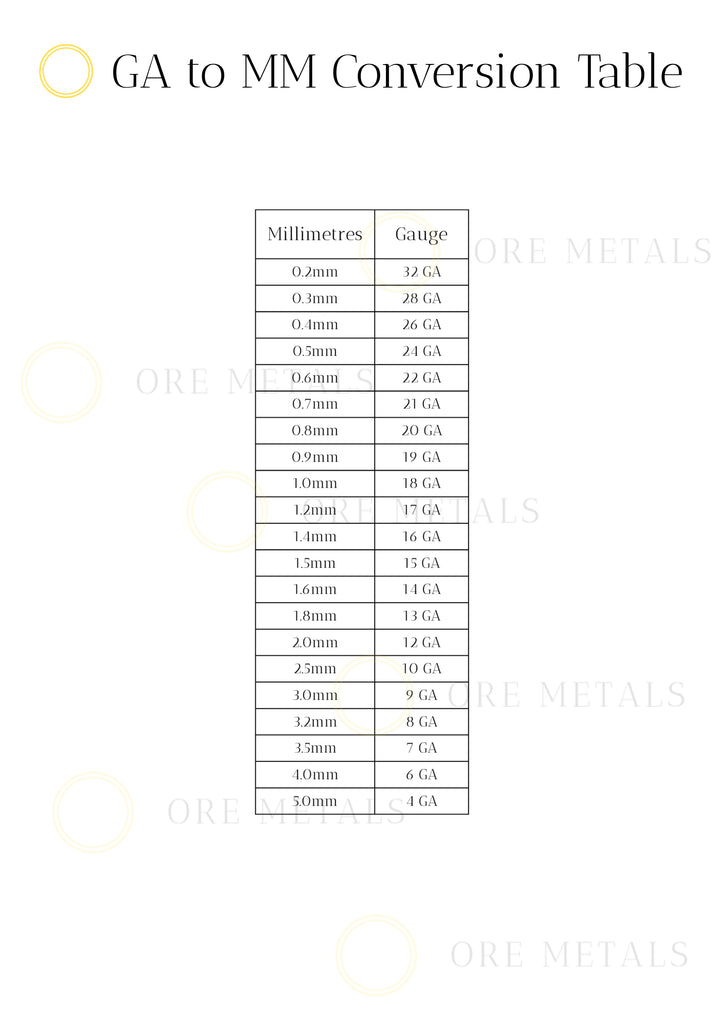GA to MM Conversion Table For Jewellery Wire

The Role of Wire in Jewellery Making
Wire is a fundamental component in a vast array of jewellery-making projects, ranging from delicate beadwork to more robust structural pieces. It serves as the backbone of many designs, providing both form and function. The thickness of the wire, measured in gauge, plays a significant role in determining the strength, flexibility, and appearance of the finished product. However, gauges can often be confusing, as they vary between different types of materials and systems. For instance, the American Wire Gauge (AWG) system differs from the Standard Wire Gauge (SWG) system used in the UK. This is where our Gauge to Millimetre Conversion Chart comes in handy.
Why Accurate Wire Measurements Are Essential
In jewellery making, the accuracy of your measurements can make or break a project. Whether you're creating a delicate chain, a robust ring, or an intricate pendant, knowing the exact thickness of your wire is crucial for ensuring that your design is both aesthetically pleasing and structurally sound. Misjudging the wire gauge can lead to issues such as weakened joints, uneven designs, and a final product that does not meet your expectations. By using our Gauge to Millimetre Conversion Chart, you can avoid these pitfalls and ensure that every piece you create meets the highest standards of quality.
How to Use the Gauge to Millimetre Conversion Chart
Our Gauge to Millimetre Conversion Chart is designed for ease of use, making it accessible to jewellers of all skill levels. To use the chart, start by identifying the gauge number of your wire or sheet metal. This number represents the thickness of the wire, with a higher gauge indicating a thinner wire. Once you have the gauge number, simply locate it on our chart to find the corresponding millimetre measurement.
For example, if you're working with a 14-gauge wire, which is a popular choice in jewellery making, our chart will show that this wire is equivalent to 1.6 millimetres in diameter. This quick-reference guide allows you to easily convert between gauges and millimetres, ensuring that you always know the exact thickness of the materials you're working with.
Enhancing Your Jewellery Projects with Accurate Measurements
Accurate measurements are the cornerstone of high-quality jewellery craftsmanship. Whether you're creating a custom piece for a client or working on a personal project, precision in your measurements will lead to more consistent and professional results. By using our Gauge to Millimetre Conversion Chart, you can ensure that each element of your design is executed with exactness.
For example, when designing a ring, the thickness of the wire used in the band is critical for both comfort and durability. A wire that is too thick may feel bulky and uncomfortable, while a wire that is too thin may not provide enough strength to hold its shape over time. By referring to our chart, you can choose the perfect wire gauge for your design, balancing both aesthetic and functional considerations.
Jewellery Wire Sizing: Gauge and Millimetre Conversion at a Glance
One of the most challenging aspects of working with jewellery wire is selecting the right size for your project. Our range of jewellery wire is clearly labelled with both the gauge and millimetre thickness, making it easier for you to find the perfect wire for your needs. This dual-labelling system eliminates the guesswork, allowing you to make informed decisions about the materials you use in your designs.
Understanding the conversion between gauge and millimetres is particularly important when working with different types of metals. For example, a 14-gauge wire made from gold will have a different weight and feel compared to a 14-gauge wire made from copper or silver. By knowing the exact millimetre measurement, you can better predict how the wire will behave in your design, ensuring that the final product meets your expectations.
Additional Resources with Every Order
At our store, we are committed to supporting your jewellery-making journey in every way possible. To that end, we include a wealth of resources with every order you place. Along with your purchase, you'll receive an information card that features our Gauge to Millimetre Conversion Chart and other valuable technical details. This handy reference guide is an essential tool for any jeweller, providing quick access to the information you need to complete your projects with confidence.
In addition to the conversion chart, the information card includes tips and best practices for working with different types of wire and metals. Whether you're a beginner looking to learn the basics or an experienced jeweller seeking advanced techniques, our resources are designed to help you succeed.
Conclusion: Simplify Your Jewellery Making Process with Precision
In the world of jewellery making, precision is more than just a skill—it's a necessity. Our Gauge to Millimetre Conversion Chart is a vital resource that ensures you can work with the exact measurements required for your projects. By taking the guesswork out of wire thickness, this chart allows you to focus on what really matters: creating beautiful, high-quality jewellery that reflects your unique vision.
Whether you're crafting intricate designs for clients or experimenting with new techniques in your workshop, our conversion chart will be your trusted guide. With accurate measurements at your fingertips, you can elevate the quality of your work and achieve results that are both consistent and professional.
Let our Gauge to Millimetre Conversion Chart be your go-to tool for all your jewellery-making needs. Explore our range of jewellery wire today, and take the first step towards mastering the art of precision in jewellery making.
